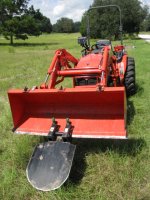Tractors are real rugged. That's part of why they maintain their value so well. As for transmission type, our tractors have had all types of transmissions in the last 40 years - straight gear, syncro-shift, power/glide shift, & HST. None of them has broken or even required any maintenance. The HST is more convenient by far - especially for loader work. The key to making them last is to ease into the work and don't slam it around.ou can
More horsepower means you can do the same job faster. More gears means you can do the same job with less hp, but it will be slower. More of both is nice, but a lot can be done with less of each.
Horsepower is only useful for comparison when it is matched to a tractor's overall weight, size, and robustness. Robust construction is something you can spot by eyeball. It usually means the tractor is built with more metal in heavier gauges - and that leads back to weight again.
Sidehill stability is paramount in sloping ground. That means weight (again) and especially weight down low. Wide stance and having fat tires with industrial rather than Ag tread helps too.
For small tractors, 4wd is a necessity. Larger Ag and utility tractors can get often get by with 2wd because they have HUGE tires that leave ruts and they aren't all that maneuverable or handy.
Lifting 2500 to 3000 lbs with a loader and then expecting to be able to drive anywhere with that load is unreasonable in a machine that is also small enough to be useful for most homeowner and small farm chores. Half that capacity is about max for a compact tractor and even then it will be tippy. It may be capable of lifting more, but moving that much weight around is a whole different story. Utility tractors and small construction machines can handle that much weight - but they are heavier machines and more expensive.
Any tractor - even the smallest 4wd ones - with a loader and a back blade will move more snow than a gang of people with snow shovels. Deep snow on uneven terrain is a problem for most any tractor that is also useful in the summer - but the tractor still beats shoveling and will eventually get the snow moved.
working in the mountains or foothills with granite soil & lots of rocks requires a whole different approach & machine than doing flat land work in loam, mud, & clay.
A front loader (FEL) and bucket with or without a grapple is the main tool on most homeowner tractors. The FEL bucket can even do a lot of the type of smoothing and grading work. Being able to quickly switch between dirt buckets and rock or grapple buckets (requires SSQA) doubles the usefulness of the tractor in rocky ground. Being able to swap specialized FEL buckets is HUGE.
A backhoe is as useful as a crane for moving things around as it is for digging holes. With a thumb on the hoe, it is doubly useful. But it's an expensive attachment.
FEL capacity is measured in cubic yards. To make it easy, most tractor FEL buckets are spec壇 in percentage of a cubic yard.
The average yellow backhoes you see on most construction sites all have a bucket that holds one cubic yard when filled to the top (not heaped). A cubic yard of dry dirt weighs a minimum of 2000 pounds. For sand or gravel about 2500 pounds. Wet any of those materials and the yard of material will be closer to 3000 lbs.
FEL lift capacity is typically measured by the manufacturer at the rear bucket pins. Buckets are fairly heavy, and the load in a bucket is already a foot or two beyond the pins, so real usable lift capacity is less than what is spec壇.
Maintaining a dirt road requires a lot of experience. For building a dirt road from scratch you'll be happier if you job it out. Even us old timers with lots of years and all the equipment have learned the value of paying a pro to put new roads.
Tractors were originally designed for PULLING, and that is still what they are best at doing. IMHO - and it's just my own opinon - most small acreage and homeowner chores are more of the landscaping type than the tractor type. If that sounds familiar, you will get more use from a TLB (tractor/loader/backhoe) than from a tractor. Take a look at the Kubota B26 or used L39. It will probably meet your needs.
Don't be afraid of low hour used machines - especially homeowner machines. With average maintenance, most any tractor on the market today is built to last far longer than the owner will.
Even if you end up with the completely wrong machine you can be assured that it will still do more work for you than you ever believed possible.
And probably be worth close to what you paid for it at trade-in time, too.
enjoy the search
rScotty
